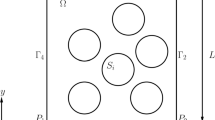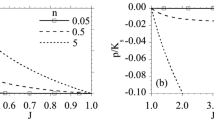The closed-cell foam is a composite with gas and solid phases. At the microlevel, the polystyrene foam was considered as a regular cellular structure whose complex of mechanical properties depends on the properties of polystyrene as an elastic-plastic material. At the macrolevel, the foam was regarded as a solid hyperelastic compressible medium, whose constants were determined in the ANSYS package according to the corresponding calculated deformation diagrams in uniaxial tension/compression, pure shear, and two- and three-axial compression. This technique was tested in the problem on indentation of a rigid sphere into the foam. The calculated indentation curves are in satisfactory agreement with experimental data.





Similar content being viewed by others
References
I. G. Romanenkov, K. V. Panferov, et al., Manual on the Physicomechanical Characteristics of Constructional Foam Plastics and Honeycombs [in Russian], Stroyizdat, Moscow (1977).
P. G. Babaevskii, A. A. Grabil’nikov, and S. G. Kulik, Industrial Polymer Composite Materials [Russian translation], Khimiya, Moscow (1980).
O. G. Tarakanov, I. V. Shamov, and V. D. Alpern, Filled Plastic Foams [in Russian], Khimiya, Moscow (1988).
U. Vaidya, Composites for Automotive, Truck and Mass Transit: Materials, Design, Manufacturing, DEStech Publications, USA (2010).
N. C. Hilliard, Mechanics of Cellular Plastics [Russian translation], Mir, Moscow (1985).
A. Jung, E. Lach, and S. Diebels, “New hybrid foam materials for impact protection,” Int. J. Impact Eng., 64, 30-38 (2014).
H. Yu, Z. Guo, B. Li, G. Yao, H. Luo, and Y. Liu, “Research into the effect of cell diameter of aluminum foam on its compressive and energy absorption properties,” Mater. Sci. Eng: A, 454/455, 542-546 (2007).
J. A. Kepler and M. R. Hansen, “Numerical modeling of sandwich panel response to ballistic loading — energy balance for varying impactor geometries,” J. Sandw. Struct. Mater., 9, 553-570 (2007).
L. J. Gibson, “Modeling the mechanical behavior of cellular materials,” Mater. Sci. Eng: A, 110, 1-36 (1989).
U. E. Ozturk and G. Anlas, “Energy absorption calculations in multiple compressive loading of polymeric foams,” Mater. Design, 30, No. 1, 15-22 (2009).
S. Ouelleta, D. Cronin, and M. Worswick, “Compressive response of polymeric foams under quasi-static, medium and high strain rate conditions,” Polym. Test., 25, No. 6, 731-743 (2006).
E. A. Flores-Johnson and Q. M. Li, “Indentation into polymeric foams,” Int. J. Solids Struct., 47, 1987-1995 (2010).
M. Brocca, Z. P. Bažant, and I. M. Daniel, “Microplane model for stiff foams and finite element analysis of sandwich failure by core indentation,” Int. J. Solids Struct., 38, Nos. 44/45, 8111-8132 (2001).
I. Jeon, T. Asahina, K.-J. Kang, S. Im, and T. J. Lu, “Finite element simulation of the plastic collapse of closed-cell aluminum foams with X-ray computed tomography,” Mech. Mater., 42, 227-236 (2010).
I. M. Daniel, J.-M. Cho, and B. T. Werner, “Characterization and modeling of stain-rate-dependent behavior of polymeric foams,” Composites: Part A, 45, 70-78 (2013).
M. M. Shokrieh and M. N. Fakhar, “Experimental, analytical, and numerical studies of composite sandwich panels under low-velocity impact loadings,” Mech. Compos. Mater., 47, No. 6, 643-658 (2011).
V. Rizov, A. Shipsha, and D. Zenkert, “Indentation study of foam core sandwich composite panels,” Compos. Struct., 69, 95-102 (2005).
S. Kishimoto, Q. Wang, Y. Tanaka, and Y. Kagawa, “Compressive mechanical properties of closed-cell aluminum foam-polymer composites,” Composites: Part B, 64, 43-49 (2014).
G. S. Langdon, D. Karagiozova, C. J. Von Klemperer, G. N. Nurick, A. Ozinsky, and E. G. Pickering, “The air-blast response of sandwich panels with composite face sheets and polymer foam cores: Experiments and predictions,” Int. J. Impact Eng., 54, 64-82 (2013).
Y. W. Kwon, R. E. Cooke, and C. Park, “Representative unit-cell models for open-cell metal foams with or without elastic filler,” Mater. Sci. Eng: A, 343, 63-70 (2003).
R. Bouix, P. Viot, and J.-L. Lataillade, “Polypropylene foam behavior under dynamic loadings: Strain rate, density and microstructure effects,” Int. J. Impact Eng., 36, 329-342 (2009).
W. Hou, F. Zhu, G. Lu, and D.-N. Fang, “Ballistic impact experiments of metallic sandwich panels with aluminium foam core,” Int. J. Impact Eng., 37, 1045-1055 (2010).
H. Jin, W.-Y. Lu, S. Scheffel, T. D. Hinnerichs, and M. K. Neilsen, “Full-field characterization of mechanical behavior of polyurethane foams,” Int. J. Solids Struct., 44, 6930-6944 (2007).
H. Mahfuz, M. S. Islam, V. K. Rangari, M. C. Saha, and S. Jeelani, “Response of sandwich composites with nanophased cores under flexural loading,” Composites: Part B, 35, 543-550 (2004).
I. Ch. Konstantinidis and S. A. Tsipas, “Symmetry effects and their influence on the mechanical behavior of open and closed cell Al foams,” Mater. Design, 31, 4490-4495 (2010).
A. M. Khanov, L. D. Sirotenko, E. V. Matygullina, I. V. Samusev, and G. V. Bashkirtsev, “Prediction of the physicomechanical properties of highly porous cellular materials on the basis of structural modeling,” Vestn. PNIPU. Ser. Mashinostr. Materialoved., 1, 17-29 (2010).
C. Barbier, P. M. Michaud, D. Baillis, J. Randrianalisoa, and A. Combescure, “New laws for the tension/compression properties of Voronoi closed-cell polymer foams in relation to their microstructure,” Europ. J. Mech. A/Solids, 45, 110-122 (2014).
I. Beverte, “Model of deformation of monotropic plastic foams parallel to the foam rise direction based on the volumedeformation hypothesis,” Mech. Compos. Mater., 37, No. 1, 23-28 (2001).
Y. Ma, X. Su, R. Pyrz, and J. Ch. Rauhe, “A novel theory of effective mechanical properties of closed-cell foam materials,” Acta Mechanica Solida Sinica, 26, No. 6, 559-569 (2013).
J.-J. Hwang, T. Adachi, T. Kuwabara, and W. Araki, “Laminate model expressing mechanical properties of polypropylene foams having non-uniform cell-shape distributions,” Mater. Sci. Eng: A, 487, 369-376 (2008).
V. R. Skvortsov, V. E. Koysin, and A. V. Shipsha, “Stability of the face layer of sandwich structures with a local interlaminar damage,” Mech. Compos. Mater., 38, No. 6, 515-524 (2002).
S. B. Sapozhnikov, Defects and Strength of Reinforced Plastics [in Russian], ChGTU, Chelyabinsk (1994).
Acknowledgments
This investigation was carried out at the South Ural State University (National Research University) with a financial support of Russian Science Foundation (project No. 14-19-00327).
Author information
Authors and Affiliations
Corresponding author
Additional information
Translated from Mekhanika Kompozitnykh Materialov, Vol. 51, No. 5, pp. 923-932 , September-October, 2015.
Rights and permissions
About this article
Cite this article
Ignatova, A.V., Sapozhnikov, S.B. Two-Scale Modeling of the Mechanical Behavior of a Composite Foam. Mech Compos Mater 51, 655–660 (2015). https://doi.org/10.1007/s11029-015-9535-2
Received:
Published:
Issue Date:
DOI: https://doi.org/10.1007/s11029-015-9535-2




